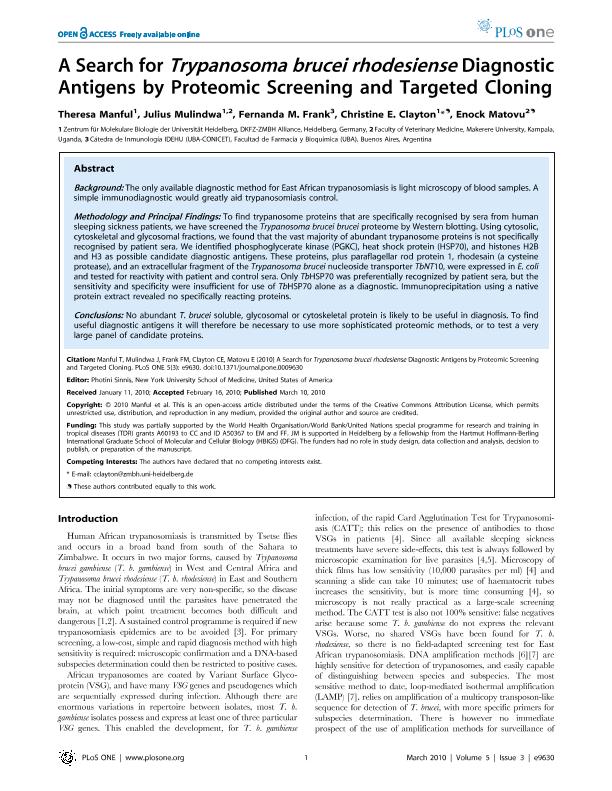Mostrar el registro sencillo del ítem
dc.contributor.author
Manful, Theresa
dc.contributor.author
Mulindwa, Julius
dc.contributor.author
Frank, Fernanda Maria

dc.contributor.author
Clayton, Christine E.
dc.contributor.author
Matovu, Enock
dc.date.available
2017-03-15T15:55:00Z
dc.date.issued
2010-03
dc.identifier.citation
Manful, Theresa; Mulindwa, Julius; Frank, Fernanda Maria; Clayton, Christine E.; Matovu, Enock; A search for Trypanosoma brucei rhodesiense diagnostic antigens by proteomic screening and targeted cloning; Public Library of Science; Plos One; 5; e963; 3-2010; 1-7
dc.identifier.issn
1932-6203
dc.identifier.uri
http://hdl.handle.net/11336/13892
dc.description.abstract
Background: The only available diagnostic method for East African trypanosomiasis is light microscopy of blood samples. A simple immunodiagnostic would greatly aid trypanosomiasis control. Methodology and Principal Findings: To find trypanosome proteins that are specifically recognised by sera from human sleeping sickness patients, we have screened the Trypanosoma brucei brucei proteome by Western blotting. Using cytosolic, cytoskeletal and glycosomal fractions, we found that the vast majority of abundant trypanosome proteins is not specifically recognised by patient sera. We identified phosphoglycerate kinase (PGKC), heat shock protein (HSP70), and histones H2B and H3 as possible candidate diagnostic antigens. These proteins, plus paraflagellar rod protein 1, rhodesain (a cysteine protease), and an extracellular fragment of the Trypanosoma brucei nucleoside transporter TbNT10, were expressed in E. coli and tested for reactivity with patient and control sera. Only TbHSP70 was preferentially recognized by patient sera, but the sensitivity and specificity were insufficient for use of TbHSP70 alone as a diagnostic. Immunoprecipitation using a native protein extract revealed no specifically reacting proteins. Conclusions: No abundant T. brucei soluble, glycosomal or cytoskeletal protein is likely to be useful in diagnosis. To find useful diagnostic antigens it will therefore be necessary to use more sophisticated proteomic methods, or to test a very large panel of candidate proteins.
dc.format
application/pdf
dc.language.iso
eng
dc.publisher
Public Library of Science

dc.rights
info:eu-repo/semantics/openAccess
dc.rights.uri
https://creativecommons.org/licenses/by/2.5/ar/
dc.subject
Trypanosoma Brucei Rhodesiense
dc.subject
Diagnosis
dc.subject.classification
Inmunología

dc.subject.classification
Medicina Básica

dc.subject.classification
CIENCIAS MÉDICAS Y DE LA SALUD

dc.title
A search for Trypanosoma brucei rhodesiense diagnostic antigens by proteomic screening and targeted cloning
dc.type
info:eu-repo/semantics/article
dc.type
info:ar-repo/semantics/artículo
dc.type
info:eu-repo/semantics/publishedVersion
dc.date.updated
2017-03-14T15:02:35Z
dc.journal.volume
5
dc.journal.number
e963
dc.journal.pagination
1-7
dc.journal.pais
Estados Unidos

dc.journal.ciudad
San Francisco
dc.description.fil
Fil: Manful, Theresa. Universität Heidelberg. Zentrum für Molekulare Biologie; Alemania
dc.description.fil
Fil: Mulindwa, Julius. Universität Heidelberg. Zentrum für Molekulare Biologie; Alemania. Makerere University. Faculty of Veterinary Medicine; Uganda
dc.description.fil
Fil: Frank, Fernanda Maria. Consejo Nacional de Investigaciones Cientificas y Tecnicas. Oficina de Coordinacion Administrativa Houssay. Instituto de Estudios de la Inmunidad Humoral "Profesor R. A. Margni"; Argentina. Universidad de Buenos Aires. Facultad de Farmacia y Bioquímica; Argentina
dc.description.fil
Fil: Clayton, Christine E.. Universität Heidelberg. Zentrum für Molekulare Biologie; Alemania
dc.description.fil
Fil: Matovu, Enock. Makerere University. Faculty of Veterinary Medicine; Uganda
dc.journal.title
Plos One

dc.relation.alternativeid
info:eu-repo/semantics/altIdentifier/url/http://journals.plos.org/plosone/article?id=10.1371/journal.pone.0009630
dc.relation.alternativeid
info:eu-repo/semantics/altIdentifier/doi/http://dx.doi.org/10.1371/journal.pone.0009630
dc.relation.alternativeid
info:eu-repo/semantics/altIdentifier/url/https://www.ncbi.nlm.nih.gov/pmc/articles/PMC2835760/
Archivos asociados
